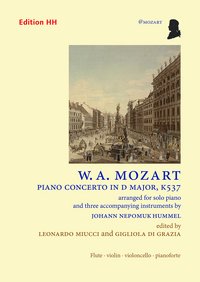W.A. Mozart: Klavierkonzert D-Dur KV 537
Wolfgang Amadeus Mozart
Piano Concerto in D major, K537, arranged for solo piano and three accompanying instruments by Johann Nepomuk Hummel
hrsg. v. Leonardo Miucci und Gigliola Di Grazia
Launton nr. Bicester 2020, Edition HH, Partitur und Stimmen (xi/53+12+2+16 Seiten)
ISBN 978-1-910359-87-7
Musical arrangement was central throughout the career of Johann Nepomuk Hummel (1778–1837), whose output includes about fifty transcriptions of pieces in a variety of musical genres, from opera overtures to symphonies and chamber music. Of particular importance are his adaptations of seven of Mozart’s piano concertos (K365, 456, 466, 482, 491, 503 and 537) for piano quartet (flute, violin, cello, fortepiano), not only for their historical significance in terms of Mozart reception, but for the invaluable information they provide about the performance practice of the time. Though partly looking to the contemporary aesthetic values of the piano, Hummel aimed to remain faithful to original classical principles, structure and musical language. His choice of instruments allowed him to preserve a satisfactory balance between the basso continuo, shared by the cello and piano, and the melody, shared by the piano and violin; the role of the flute was mainly to represent the typical tone of the woodwinds. Most notable with regard to performance practice are Hummel’s efforts to complete Mozart’s text in line with standard 18th-century convention, in passages where the original notation is sparse, or at least not fully comprehensive. His realizations, for example, shed light on such problematic questions as improvised embellishment and the treatment of Eingänge (lead-ins).
Hummel’s arrangement of the Piano Concerto in D major, K537, the fifth in the series to appear, was published in 1835. The lead-in (Eingänge) models that he provided are particularly valuable in the case of K537, which is among those concertos for which Mozart left no written-out examples. Equally importantly, Hummel might well have witnessed the work’s compositional process and first performance, and thus his own contributions could be considered as authoritative.
